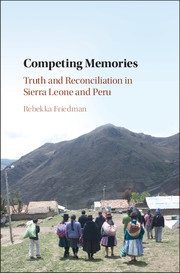Book contents
- Competing Memories
- Competing Memories
- Copyright page
- Contents
- Figures
- Acknowledgments
- Abbreviations and Definitions
- 1 Justice and Reconciliation in Enduring Conflicts
- 2 Contextual Variances, Transitional Justice, and Peace-Building
- 3 Procedural Reconciliation
- 4 Underdevelopment, Peace-Building, and Marginalization
- 5 Localism and Pragmatic Solidarity in Sierra Leone
- 6 The Shining Path and Political Violence: The Establishment of a Punitive Human Rights–Based Approach
- 7 Memory Activism and the Politics of the Past
- 8 Conclusions
- Book part
- Bibliography
- Index
- References
Bibliography
Published online by Cambridge University Press: 30 August 2017
- Competing Memories
- Competing Memories
- Copyright page
- Contents
- Figures
- Acknowledgments
- Abbreviations and Definitions
- 1 Justice and Reconciliation in Enduring Conflicts
- 2 Contextual Variances, Transitional Justice, and Peace-Building
- 3 Procedural Reconciliation
- 4 Underdevelopment, Peace-Building, and Marginalization
- 5 Localism and Pragmatic Solidarity in Sierra Leone
- 6 The Shining Path and Political Violence: The Establishment of a Punitive Human Rights–Based Approach
- 7 Memory Activism and the Politics of the Past
- 8 Conclusions
- Book part
- Bibliography
- Index
- References
- Type
- Chapter
- Information
- Competing Memories , pp. 191 - 208Publisher: Cambridge University PressPrint publication year: 2017



